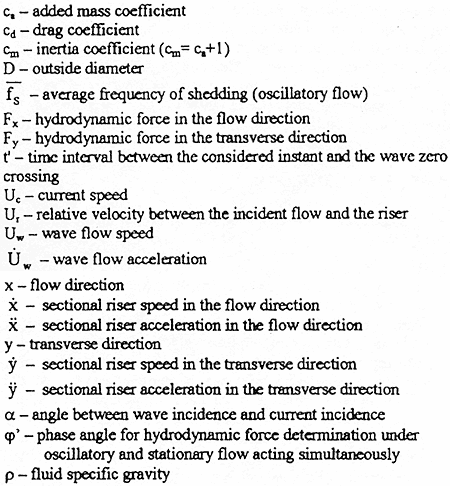Proceedings of the Tenth (2000) International Offshore and Polar Engineering Conference
Seattle, USA, May 28-June 2, 2000
Copyright©2000 by The International Society of Offshore and Polar Engineers
ISBN 1-880653-46-X (Set); ISBN 1-880653-48-6 (Vol. II): ISSN 1098-6189 (Set)
Fatigue Design of Risers: An Improved Methodology Incorporating a Transverse Hydrodynamic Force Model
O.B. Sertã
Petrobras S.A., Rio de Janeiro, Brazil
S.H. Sphaier and A.C. Fernandes
COPPE/UFRJ, Rio de Janeiro, Brazil
ABSTRACT
Vortex Induced Vibrations (VIV) are responsible for great part of the fatigue damage caused by the dynamic loading that occurs in compliant offshore structures such as risers. The codes, like the API RP 2RD ("Design of Risers for Floating Production Systems and Tension-Leg Platforms"), typically require the design fatigue life to be larger than 10 times the structure service life. However, because the normal dynamic models available for riser analysis do not have a formulation for the fluid transverse induced force, the fatigue damage is obtained without its consideration. The VIV damage may be assessed by specific models that consider it isolated, but there is no reliable means to calculate the total damage based on these two damage sources. To avoid this kind of uncertainty, a strategy is to use VIV supressors, if the risk of having VIV is considered significant, but this solution could be avoided in certain cases if a better methodology and appropriate model were available.
This paper present a summary of a research work that was carried out to improve the design methodology of individual risers, in the sense of integrating the fatigue life assessment by considering all sources of damage, including VIV.
KEY WORDS: VIV, Vortex Induced Vibration, Riser Design, Fatigue
Riser Behavior
LIST OF SYMBOLS

INTRODUCTION
The exploitation of oil in deeper waters has brought a constant change in the design practice of risers. For instance, the available practical guides do not establish a closed procedure to be applied in the design, although they recommend to account for the influence of vortex induced vibrations in the fatigue calculation.
During its operation life, a riser it is exposed to different combinations of loads caused by the action of currents, waves and induced platform motion to the top connection. These loads have a fluctuating parcel that cause cyclic stresses in the riser wall. Among those oscillating excitation, the vortex shedding deserves special attention. In this context, the design of risers should include the fatigue damage assessment, in order to guarantee that they will keep structural integrity during their service life.
The present work focus on some strategies that may be implemented to improve the procedures usually used for determining the fatigue damage of risers caused by typical excitations, that include vortex shedding. The proposed design procedure will be validated by small scale tests and by the data acquired during the monitoring program on course for the Steel Catenary Riser (SCR) of the P-18 semi-submersible platform, installed in the Marlim Field.
SOME BASIC CONCEPTS
A lot of effort has been devoted to improve the understanding of the vortex shedding phenomena and to evaluate more realistically the in-line and transversal induced forces. In the literature several very comprehensive reviews have been published (Pantazopoulos 94), (King 97), (Bearman 92), (Bearman 84), (Bearman 88), (Bearman 96)).